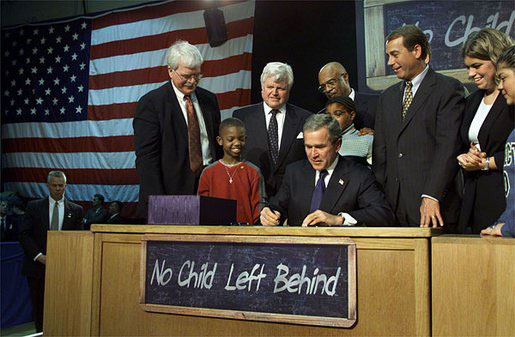
More than 30 states across the country have gotten waivers from No Child Left Behind. That lets them judge schools with their own measures instead of the federal standards. Alaska joined has that bunch.
Last year, more than half of Alaska’s schools got a failing grade under No Child Left Behind. Next year would have been even worse, according to the state’s Department of Education and Early Development. Deputy Commissioner Les Morse says that not a single school in the state would have passed.
“Next year, every school had to have all their students –100 percent of their students — at proficient. That includes every student who might be struggling in learning, a brand new student to the country who might not know English … All of the them would have to score proficient on the assessments. Otherwise, the school would be deemed as a failing school under the current law.”
On top of the black eye of getting a failing grade, schools would have had to tie up funding in federally mandated tutoring programs. And they would have had to put money toward letting kids transfer to passing schools. Morse says that would have been tricky if there weren’t any passing schools.
“If every school is failing, it’s at a point where that just doesn’t make sense.”
So, like a lot of states, Alaska applied for an exemption from the federal education law. What that means is that instead of being judged primarily on math and reading proficiency tests, things like attendance, the number of kids who take the SAT, and the annual improvement that students show will also be taken into account. And instead of passing or failing, schools will get star ratings, with five being the best — kind of like movie reviews.
Morse says that because the state will now be taking a more complex approach to gauging student achievement, some of the tests will even be harder. The difference is that schools won’t be faced with an automatic failing grade if some students don’t pass the standards test, and they’ll be given a chance to target specific areas of improvement.
“By no means is the waiver is the waiver saying that we think we ought to give up on any child. Actually, we’ve raised the standards, but now instead of saying we want kids to meet a minimum, we’re actually going to build supports and targets to help make sure kids, when they graduate from high school are ready for college if they want to go to college or any post-secondary training opportunity.”
Opinion on the waiver has been generally positive. The Alaska Council of School Administrators says they’re embracing it, while the Alaska Association of School Boards calls it a step forward. But Republican Sen. Lisa Murkowski did show some skepticism toward the waiver, suggesting that it could be a “half measure” that replaces federal regulations with a similar set of requirements.
